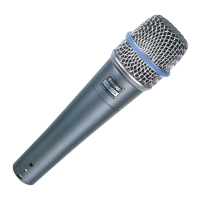Shure Incorporated
5/7
Proximity Effect
Unidirectional (cardioid) microphones progressively boost bass frequencies by 6 to 10 dB below 100 Hz when the microphone
is at a distance of about 6 mm (1/4 in.) from the sound source. This phenomenon, known as proximity effect, can be used to
create a warmer, more powerful sound. To prevent explosive low frequency sound during close-up use, the bass response
gradually rolls off. This provides greater control and helps the user take advantage of proximity effect.
Specifications
Type
Dynamic (moving coil)
Frequency Response
50to16,000Hz
Polar Pattern
Supercardioid
Output Impedance
290Ω
Sensitivity
at 1kHz, open circuit voltage
-51dBV/Pa(2.8mV)[1]
Weight
Net
0.275kg(0.6lbs)
Connector
Three-pin professional audio (XLR), male, balanced
Housing
Silver blue enamel-painted die cast metal with hardened, matte-finished steel mesh grille
[1] 1 Pa=94 dB SPL

